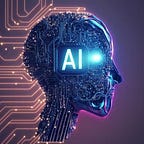Building Your Own AI Image Classifier with Python — No Magic, Just Code ✨!
Hey, fellow tech enthusiasts and AI dreamers! Today, we’re diving into the fascinating world of ️IMAGE CLASSIFICATION➡️, where computers learn to see the world just like us (well, almost )!
Imagine: you point your phone at a flower, and BAM! It tells you the species. Or you snap a picture of your messy desk, and suddenly, you have a to-do list for each object in the frame. Pretty cool, right?
Building an image classifier might sound like something out of sci-fi, but with a dash of Python and TensorFlow, it’s surprisingly achievable. Buckle up, because we’re about to unlock the secrets of AI with code!
Step 1: Training our AI Eyes ️
Think of your AI as a curious baby learning to identify toys. First, we show it tons of pictures ️, each labeled with its name (like “cat”, “car”, or “chaos on my desk” ☕️). These are our training images and labels ️. The more diverse the pictures ️️, the better our AI understands the world.
Step 2: The Magic (Kinda) Happens ✨🪄
Now comes the cool part: TensorFlow, our code playground ⚙️, transforms these images into numbers that the AI can understand. It’s like whispering the secrets of each picture in a language only machines speak ️. This process, called feature extraction, helps the AI recognize patterns and learn the differences between cats, cars, and coffee cups ☕️.
Step 3: Show and Tell
After all this training, it’s quiz time! We feed the AI a new image ❓, and it uses its newfound knowledge to guess what it sees. Imagine the AI squinting at the picture, whispering to itself, “Hmm, those furry ears and pointy muzzle… definitely a cat! “! This final step, called prediction ✨, is where the magic (or rather, clever coding ) shines.
Let’s Talk Code!:
Remember the baby learning toys? Here’s a peek at the Python code that helps our AI train its eyes ️:
import tensorflow as tf
# Load the MNIST dataset (images of handwritten digits)
mnist = tf.keras.datasets.mnist
(x_train, y_train), (x_test, y_test) = mnist.load_data()
# Build a simple CNN model (Convolutional Neural Network, like brain wrinkles for images) ️
model = tf.keras.Sequential([
tf.keras.layers.Flatten(input_shape=(28, 28)),
tf.keras.layers.Dense(128, activation="relu"),
tf.keras.layers.Dense(10, activation="softmax")
])
# Train the model (think of it as showing the baby lots of toys)
model.compile(loss="sparse_categorical_crossentropy", optimizer="adam", metrics=["accuracy"])
model.fit(x_train, y_train, epochs=5)
# Test the model (time for the quiz!)
loss, accuracy = model.evaluate(x_test, y_test)
print(f"Test accuracy: {accuracy}")This code might seem like gibberish , but trust me, it’s the secret sauce that teaches our AI to see. Each line builds upon the last, creating a network ️ that analyzes images ️ and spits out guesses.
Here’s how we can break down the code snippet and explain it in a friendly way:
Imports and Data Prep:
import tensorflow as tf: We're importing TensorFlow, the library we'll use to build our AI model.mnist = tf.keras.datasets.mnist: We're downloading the MNIST dataset, which contains thousands of handwritten digits (0-9) labeled with their corresponding number. We'll use this dataset to train our AI to recognize digits.(x_train, y_train), (x_test, y_test) = mnist.load_data(): This splits the dataset into training data (x_train and y_train) and testing data (x_test and y_test). The training data will be used to teach the AI, while the testing data will be used to evaluate its accuracy once it's trained.
Building the AI Model:
model = tf.keras.Sequential([...]): We're creating aSequential` model, which means the layers will be stacked one after another.tf.keras.layers.Flatten(input_shape=(28, 28)): This first layer flattens each image in the dataset from a 28x28 grid of pixels into a single, long list of pixel values. This makes it easier for the next layers to process the images.tf.keras.layers.Dense(128, activation="relu"): This layer adds 128 "neurons" to the model. Each neuron takes the input from the previous layer and performs a calculation on it. The "relu" activation function adds some non-linearity to the calculations, which helps the model learn complex patterns.tf.keras.layers.Dense(10, activation="softmax"): This final layer has 10 neurons, one for each possible digit (0-9). The "softmax" activation function ensures that the output of these neurons will sum to 1, like probabilities. The neuron with the highest output will be the AI's predicted digit for the image.
Training the AI:
model.compile(loss="sparse_categorical_crossentropy", optimizer="adam", metrics=["accuracy"]): This configures the training process. We're using "sparse_categorical_crossentropy" as the loss function, which measures how different the AI's predictions are from the correct answers. "Adam" is the optimizer, which helps the model adjust its internal weights and biases to improve its accuracy over time. "Accuracy" is the metric we'll use to track how well the AI is performing.model.fit(x_train, y_train, epochs=5): This starts the training process. We're feeding the training data (x_train and y_train) to the model and telling it to train for 5 "epochs" (iterations through the entire dataset).
Testing and Evaluation:
loss, accuracy = model.evaluate(x_test, y_test): This uses the testing data (x_test and y_test) to evaluate the AI's accuracy after training. The returnedlossandaccuracyvalues tell us how well the AI performed on the unseen data.
Beyond Numbers: The Future of AI Vision
Image classification isn’t just a party trick. It’s used in medical imaging, self-driving cars, and even sorting your recycling ♻️! As AI vision evolves, the possibilities are endless ♾️. Imagine robots helping surgeons in real-time 🩺, or smartphones identifying endangered species in the wild.
So, why not join the revolution ✊? Building your image classifier is not only a fantastic learning experience, but it also opens doors to the exciting world of AI ✨
